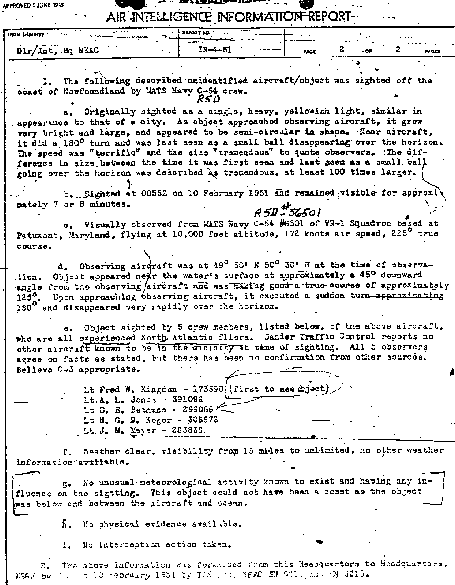U.S. Naval Reserve Lieutenant Graham Bethune, co-pilot on Flight 125 from Keflavik, reported:
"While flying in the left seat on a true course of 230 degrees at a position of 49-50 North and 50-03 West, I observed a glow of light below the horizon about 1,000 to 1,500 feet above the water. We both observed its course and motion for about 4 or 5 minutes before calling it to the attention of the other crew members... Suddenly its angle of attack changed, its altitude and size increased as though its speed was in excess of 1,000 miles per hour. It closed in so fast that the first feeling was we would collide in midair. At this time its angle changed and the color changed. It then [appeared] definitely circular and reddish orange on its perimeter. It reversed its course and tripled its speed until it was last seen disappearing over the horizon. Because of our altitude and misleading distance over water it is almost impossible to estimate its size, distance, and speed. A rough estimate would be at least 300 feet in diameter, over 1,000 miles per hour in speed, and approached to within 5 miles of the aircraft."
|
AIR INTELLIGENCE INFORMATION REPORT
Dir/Int, Hq
NEAC
IR-4-51
page 2 of 2 pages
1. The following described unidentifed aircraft/object was sighted off the coast of Newfoundland by MATS Navy C-54 crew.
a. Originally sighted as a single, heavy, yellowish light, similar in appearance to that of a city. As object approached observing aircraft, it grew very bright and large, and appeared to be simi-circular in shape. Near aircraft, it did a 180 degree turn and was last seen as a small ball disappearing over the horizon. The speed was "terrific" and the size "tremendous" to quote observers. The difference in size between the time it was first seen and last seen as a small ball going over the horizon was described as tremendous, at least 100 times larger.
b. Sighted at 0055Z on 10 February 1951 and remained visible for approximately 7 or 8 minutes.
c. Visually observered from MATS Navy C-54 #56501 of VR-1 Squadron based at Patuxent, Maryland, flying at 10,000 feet altitude, 182 knots air speed, 225 degrees true course.
d. Observing aircraft was at 4950N 5030W at the time of observation. Object appeared over the water's surface at approximately a 45 degree downward angle from the observing aircraft and was making good a true course of approximately 125 degrees. Upon approaching observing aircraft, it executed a sudden turn approximating 180 degrees and disappeared very rapidly over the horizon.
e. Object sighted by 5 crew members, listed below, of the above aircraft, who are all experienced North Atlantic fliers. Gander Traffic Control reports no other aircraft known to be in the vicinity at time of sighting. All 5 observers agree on facts as stated, but there has been no confirmation from other sources. Believe C-3 appropriate.
Lt Fred W. Kingdon - 173390 (First to see object)
Lt A. L. Jones - 391096
Lt G. E. Bethune - 299055
Lt N. G. S. Koger - 305875
Lt J. M. Mayer - 283836
f. Weather clear, visibility from 15 miles to unlimited, no other weather information available.
g. No unusual meteorological activity known to exist and having any influence on the sighting. This object could not have been a comet as the object was below and between the aircraft and ocean.
h. No physical evidence available.
i. No interception action taken.
2. The above information was forwared from this Headquarters to Headquarters,
USAF by ** on 10 February 1951 by ******, NEAC E*
**** *** ** 0215.

|